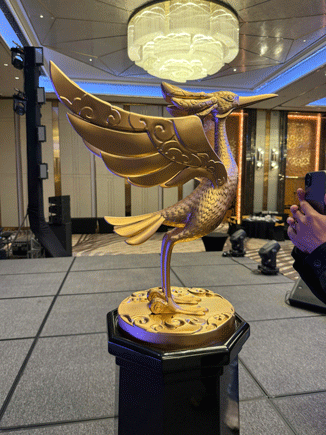I. Details of the Ly Dynasty Dragon
Since ancient times, the Dragon has existed in the Vietnamese people’s consciousness, with many legends about the dragon, with sacred manifestations, about the development, as we are proud to be descendants of Lac Hong (Lac Long Quan and Au Co). The Dragon is associated with folk beliefs. The Dragon is a sacred symbol, bringing favorable weather, the wish and desire of the life of wet rice farmers. It is creatively promoted in the art of the royal court, communal houses, temples, and traditional pagodas, forever deeply rooted in the people’s subconscious.
Thang Long is where the Golden Dragon appeared. The creative image of the Ly Dragon is also a preservation of the traditional dragon of the nation. The Ly Dynasty maintained and preserved the symbols of the traditional Dragon, and brought back a new meaning of royalty. The image of the Dragon in the Ly Dynasty became a noble symbol – the authority of the Royal Power and the sacredness of the Divine Power (with Buddhism as the National Religion).
The image of the Dragon only really developed from the Ly Dynasty (XI-XII century), opening the Dai Viet civilization after a thousand years of Chinese domination. This was the period when Buddhism was strongly developed, the spirit of national self-reliance was always promoted, many cultural and artistic works were built, and decorative art patterns were also rich and diverse. The image of the Dragon is sacred and noble. The lines are soft, delicate, the layout is complete and consistent, and the style is clear. Regarding the shape, block, and shape of the Ly Dragon: most of the carvings are not too deep (ie the block does not make the carvings high), but mainly pay attention to the shape, with a lot of painting. Therefore, when printing Do paper on the carvings, it is relatively easy to carry out. The layout of the Ly Dragon: is classified into geometric types. For example: Rectangular layout: such as the stone carvings “Dragon image facing Bodhi leaf, symmetrical on both sides are images of fairies, musicians dancing and singing” (base of the column of Phat Tich pagoda – year 1057). “Dragon image facing Bodhi leaf”, “Dragon image on pedestal” (Buddha statue, Phat Tich pagoda – year 1066, Phat Tich commune – Tien Son – Bac Ninh). “Dragon image on the stone wall” (Chuong Son tower – year 1117), or “Dragon image on terracotta” discovered in the Thang Long citadel area. Dragon image in circular layout: such as the stone carving “Dragon image and flower vine” (Chuong Son tower – year 1118, Yen Loi – Y Yen – Nam Dinh). Dragon image in semicircular layout: “Dragon images facing”, (stone carving – year 1118, on the forehead of the stele of Long Doi pagoda – Doi Son – Duy Tien – Ha Nam). Dragon image in the Bodhi leaf-shaped layout: “Dragon image offering Jade”, Ceramic (discovered in the Thang Long Citadel area, Hanoi). Dragon image in the Lotus petal-shaped layout: “Dragon image in the Lotus petals” on the pedestal (Chuong Son Tower – year 1117), or “Dragon image on the Lotus petals” carved on the stone pillar supporting the column base in some Ly architectural works that Archaeology discovered in the Thang Long Imperial Citadel area…
Characteristics of the Dragon image in the Ly Dynasty: the Dragon’s body is elongated, shown in a side view. The Dragon’s head with its neck tilted up high. On the Dragon’s eyebrows, there is a spiral like the number 3 upside down (according to the Buddhist Golden Ring), and on the forehead, there is a spiral like the letter S standing upright (a symbol resembling the lightning of the ancient natural phenomenon of the power of the Buddha Dharma Thunder – Dharma Lightning (thunder and lightning). Behind the Dragon’s nape, from both sides below the ears, there is a mane with many tassels tied together, flying and curving, pointedly pointing behind. The beard under the Dragon’s chin is also twisted and curving similarly below, but smaller and shorter. Around the head, there are floating pearls and often have clouds wrapped around it. The Dragon’s mouth is wide open to catch the precious pearl. On the two jaws, there are sharp teeth, the two fangs at the end of the jaw extend and curve over the edge close to the nose. The Dragon’s nose is also extended into a crest in the shape of a trunk. The Dragon’s crest is also slightly curved and surrounded by a flame-like border. The Dragon’s lower lip is short, while the tongue is very long. From the lower jaw, the tongue extends out in a wavy wave to support the floating pearl. The Dragon’s eyes are large, round and slightly convex. There is also another type of Dragon head: neck curving down and then up (the Dragon’s neck looks like it’s shrinking) – like the pair of dragons carved on the forehead of the Bao An Pagoda stele (Thanh Hoa). Or the dragons lining up one after another on the steps of the Sung Nghiem Dien Khanh Pagoda.
II. 3D scanning of Ly Dynasty Dragon for research and production at Scantech3D
At Scantech3D, the Ly Dynasty Dragon statue is scanned with a Steinbichler scanner, which is stable and produces clear images, which is very effective for the 3D data construction process. The scanned data is used to digitize fine art data, while also helping to shorten the manufacturing time, and can be 3D printed into multiple copies with a breakthrough time. Now, to have a Ly Dynasty Dragon statue, you no longer need to craft it manually. Mastering modern technology allows you to create anything!
OTHER NEWS













